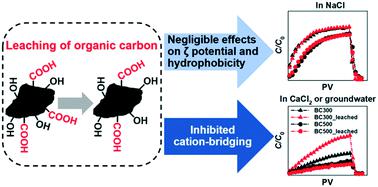当前位置:
X-MOL 学术
›
Environ. Sci.: Nano
›
论文详情
Our official English website, www.x-mol.net, welcomes your
feedback! (Note: you will need to create a separate account there.)
Leaching of organic carbon enhances mobility of biochar nanoparticles in saturated porous media
Environmental Science: Nano ( IF 5.8 ) Pub Date : 2021-07-15 , DOI: 10.1039/d1en00409c Pengkun Ma 1, 2, 3, 4, 5 , Cuiyi Yang 1, 2, 3, 4, 5 , Meiling Zhu 1, 2, 3, 4, 5 , Lihua Fan 1, 2, 3, 4, 5 , Wei Chen 1, 2, 3, 4, 5
Environmental Science: Nano ( IF 5.8 ) Pub Date : 2021-07-15 , DOI: 10.1039/d1en00409c Pengkun Ma 1, 2, 3, 4, 5 , Cuiyi Yang 1, 2, 3, 4, 5 , Meiling Zhu 1, 2, 3, 4, 5 , Lihua Fan 1, 2, 3, 4, 5 , Wei Chen 1, 2, 3, 4, 5
Affiliation

|
Application of biochar materials generates large quantities of nanoparticles that possess relatively high mobility and can facilitate the transport of environmental contaminants. Here, we show that leaching of organic carbon (OC), an important weathering process of biochar, can markedly enhance the mobility of biochar nanoparticles. The nanoparticles of rice straw biochar and moso bamboo biochar receiving treatment to leach out OC exhibit a similar morphology and size distribution to the nanoparticles of the untreated biochar materials, but slightly different surface chemical properties, in particular, lower contents of carboxyl groups. Even though this alteration is too small to affect the surface charge negativity and hydrophobicity of the biochar nanoparticles, it considerably enhances the mobility of the biochar nanoparticles in artificial groundwater-saturated sandy soil, while having negligible effects on the mobility of the nanoparticles in purified quartz sand. Supplementary transport and particle remobilization experiments carried out in 20 mM NaCl and 0.68 mM CaCl2, along with calculations of particle–collector interaction energy profiles based on extended Derjaguin–Landau–Verwey–Overbeek (XDLVO) theory, verify that the OC-deficient nanoparticles are less affected by cation bridging between the nanoparticles and soil grains, owing to their lower abundance of carboxyl groups. The OC-leaching-induced mobility enhancement is more pronounced for low-temperature biochar materials (300 °C) than for high-temperature ones (500 °C), as the former can leach out greater amounts of OC. The findings call for further understanding of the effects of environmental aging processes on the fate and effects of biochar nanoparticles.
中文翻译:

有机碳的浸出增强了生物炭纳米颗粒在饱和多孔介质中的迁移率
生物炭材料的应用产生了大量具有相对较高迁移率的纳米颗粒,可以促进环境污染物的传输。在这里,我们表明有机碳(OC)的浸出是生物炭的重要风化过程,可以显着提高生物炭纳米颗粒的流动性。接受浸出 OC 处理的稻草生物炭和毛竹生物炭的纳米颗粒与未经处理的生物炭材料的纳米颗粒具有相似的形态和尺寸分布,但表面化学性质略有不同,特别是羧基含量较低。尽管这种改变太小而无法影响生物炭纳米粒子的表面电荷负性和疏水性,它大大提高了 biochar 纳米粒子在人工地下水饱和沙质土壤中的迁移率,而对纳米粒子在纯化石英砂中的迁移率的影响可以忽略不计。在 20 mM NaCl 和 0.68 mM CaCl 中进行的补充转运和粒子再动员实验2,连同基于扩展的 Derjaguin-Landau-Verwey-Overbeek (XDLVO) 理论的粒子 - 收集器相互作用能量分布的计算,验证缺乏 OC 的纳米粒子受纳米粒子和土壤颗粒之间的阳离子桥接的影响较小,因为它们羧基的丰度较低。低温生物炭材料(300°C)的OC浸出诱导的迁移率增强比高温生物炭材料(500°C)更明显,因为前者可以浸出更多的OC。研究结果呼吁进一步了解环境老化过程对生物炭纳米粒子的命运和影响的影响。
更新日期:2021-08-02
中文翻译:

有机碳的浸出增强了生物炭纳米颗粒在饱和多孔介质中的迁移率
生物炭材料的应用产生了大量具有相对较高迁移率的纳米颗粒,可以促进环境污染物的传输。在这里,我们表明有机碳(OC)的浸出是生物炭的重要风化过程,可以显着提高生物炭纳米颗粒的流动性。接受浸出 OC 处理的稻草生物炭和毛竹生物炭的纳米颗粒与未经处理的生物炭材料的纳米颗粒具有相似的形态和尺寸分布,但表面化学性质略有不同,特别是羧基含量较低。尽管这种改变太小而无法影响生物炭纳米粒子的表面电荷负性和疏水性,它大大提高了 biochar 纳米粒子在人工地下水饱和沙质土壤中的迁移率,而对纳米粒子在纯化石英砂中的迁移率的影响可以忽略不计。在 20 mM NaCl 和 0.68 mM CaCl 中进行的补充转运和粒子再动员实验2,连同基于扩展的 Derjaguin-Landau-Verwey-Overbeek (XDLVO) 理论的粒子 - 收集器相互作用能量分布的计算,验证缺乏 OC 的纳米粒子受纳米粒子和土壤颗粒之间的阳离子桥接的影响较小,因为它们羧基的丰度较低。低温生物炭材料(300°C)的OC浸出诱导的迁移率增强比高温生物炭材料(500°C)更明显,因为前者可以浸出更多的OC。研究结果呼吁进一步了解环境老化过程对生物炭纳米粒子的命运和影响的影响。











































 京公网安备 11010802027423号
京公网安备 11010802027423号